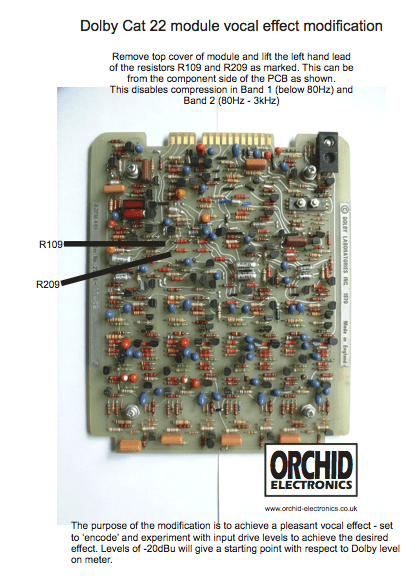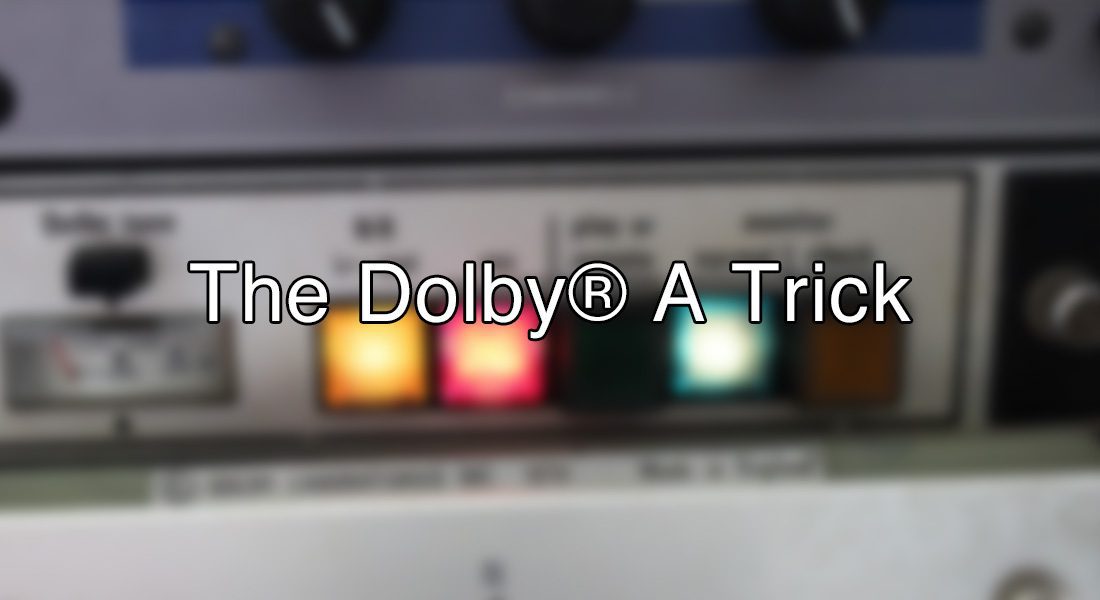The Dolby® A Trick
The Dolby® A Trick was a technique used in the late 60s and early 70s to enhance the top end of recordings, especially vocal tracks, by using the encoding stage of a noise reduction unit.
Noise Reduction or Enhancer?
Introduced in 1966 with the Dolby® A301 first, and then in 1970 with the Dolby® 361 (with the CAT 22 card, in photos), the A-Type noise reduction was quickly misused and modded by engineers to enhance their recordings by using the encoding stage only. The most common mod consists of disabling the two lower bands so that only the high-frequency portion of the signal is compressed, giving even more air to vocals. This technique was labeled with many names like the Vocal Trick, Air Hack, Stretch Mod, Vocal Stressor, and even the “John Lennon mod”.
How does it work?
To limit the amount of noise generated by tape recording, early noise reduction systems used what’s called a multi-band compander (compressor/expander).
The unit dynamically emphasizes the high frequencies during the encoding stage (recording to tape), so that during the decoding stage (playback from tape) the signal is attenuated, along with the typical tape noise. By using the encoding stage only, you can obtain a natural enhancing effect, increasing the top end of any track.

As you can see from the picture above, in the encoding stage, the input signal is split into 4 bands (with the highest bands overlapping), dynamically compressed, and then summed back with the dry signal. The amount of compression on each band is inversely proportional to the volume of the band. Quieter sounds get brighter while louder sounds remain almost unchanged.
This adds brightness and air without generating any new harmonic content or distortion, resulting in a more pleasant and natural enhancer compared to a typical exciter.
Bands
The bands are divided as follow:
- Band 1 has a low pass filter around 80Hz.
- Band 2 is the results of the input signal minus band 1 and 3, essentially a band pass filter from 80Hz to 3kHz.
- Band 3 has a high pass filter around 3kHz.
- Band 4 has a high pass filter around 9kHz.
These bands were chosen by Dolby® for level content and its effectiveness in eliminating tape hiss in the record/playback process. The overlapping high bands (3 and 4) work very well for the enhancing process.
Tricks or Mods?
As said before, the most common mod to the Dolby® units consists of disabling the two lower bands so that only the high-frequency portion of the signal is compressed, giving even more air to vocals.
With the early units like the A301, this process was easy to do because each band compression circuit was on a separate card. You could just pull off the band you didn’t want to process and experiment with the results. With other units like the Dolby® 360 or 361 the four bands are all condensed together in a single card.

Type A
We’ve studied this effect for almost 2 years and we are proud to have realized one of the most accurate and complete plugin emulations so far: Type A.
Type A gives you the ability to “mod” the unit by switching the bands on and off, changing their gains, and adjusting the compressor attack and release parameters.
If you want to read more, you can check this comparison between Type A, a Dolby® 361A and a competitor plugin.
My thoughts, along with the “comparison solution” can be found directly here.
Direct vs Dry
The Wet signal contains a copy of the Dry signal “Direct” (see fig. in “How does it work?”), regardless of the Mix control. You can disable it by switching off the Direct button. The difference between the Direct signal and the Dry signal (which you can dial in with the Mix control) is that Direct is also affected by the Input control, while the Dry signal is passed unchanged.
Sign up to our newsletter for more creative tips or learn more about Type A.


